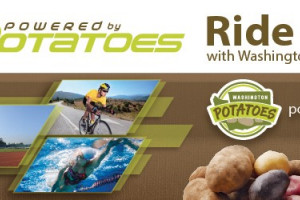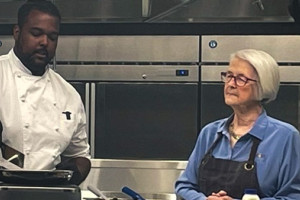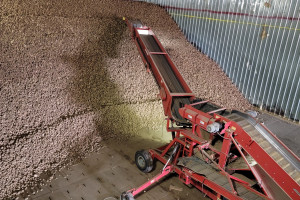Cooper River Bridge Run — Getting over it in Charleston, South Carolina
We couldn’t have asked for a more convenient arrangement when it came to this year’s 47th annual Cooper River Bridge Run. Perhaps only the solar eclipse on April 8th was more perfectly aligned than how our travel plans fell into place on April 6th. I had booked a family vacation to Charleston, Columbia and Savannah back in February. A month later I realized we would be in Charleston the same day as one of the country’s biggest 10K races. Talk about perfect timing. And if I needed an incentive to sign us up for the race—our hotel was one block from the Race Expo and the shuttle bus stops for whisking you off to the start line and bringing you back from the finish line. We had no reason not to register for this race!

I had long been familiar with the Cooper River Bridge Run and always wanted to run it. It’s one of the country’s classic 10K runs. Started back in 1978 during the original Running Boom, this race has become the country’s 3rd largest 10K, just behind Atlanta’s Peachtree 10K, and Boulder’s BOLDERBoulder 10K. It would be the biggest race that I’ve ever run—and I’ve been running races since the 80s. For my 9 year old son, it would not only be his biggest race too, but also his first 10K. My wife was excited to run this race too and we would all be participating as proud members of Team Potato. Potato to Palmetto!
I was able to get my son on a few five mile training runs prior to the race. Race day would be his longest run to date. For me an ultra-runner, it would just be a short run! But I wanted to see if I still had any speed in me, and fortunately I qualified to be in one of the front corrals so that I could let loose without dodging the masses.

We arrived in Charleston after a cold front moved through the area. We wouldn’t be worrying about heat and humidity during the race. Little did we know at the time that cold temps and strong winds would be a factor. The day before the race we walked a 10K through the fascinating city on urban trails and narrow city streets lined with historic homes, churches and other institutions. Charleston was founded in the 1670s, one of our oldest cities. And while this port city with its cobblestone roads, palmettos, rows of live oaks draped in Spanish moss, and beautiful buildings is charming—its history has some dark epochs. We visited Fort Sumter (where the Civil War began) and the National African American Museum (built on Gadsden’s Wharf where 40% of all African slaves brought to America landed) for some tough but vital history.
On race morning we woke up at 0-dark thirty to get on a school bus that would shuttle us off to the start in the city of Mount Pleasant (named for an old plantation—the Low Country is as flat as it gets). A procession of buses took off from our departure area as well as three other areas delivering nearly 27,000 runners and walkers to the starting area. The race’s motto is, “Get over it!” A nice play on moving over that bridge. For many runners it’s an annual passage to get over it! And for many others—including us—it would be the first time we get over it! My son soon got over the fact that he was tired and cold once we all got moving!

Big races are lots of fun for the energy they harness and the diversity of people they attract. But they also have their setbacks—like long lines at the porta-potties and having to wait outside for a long time before the starting gun. Making the wait difficult this morning was the 47 degree temperature and a cool north wind that kept us shivering. We weren’t prepared for the cold. We had dressed for South Carolina, not South Dakota.
But despite all of the people and the commotion, the race was well organized and the community was well behind it. With the street closed to traffic, I got a kick out of the local Dunkin Donuts servicing runners in the drive-thru. Last thing I wanted was more coffee and having to get in line again for the privy. At 8 am we were off. I was in Corral A, the first after the seeded elite runners which meant I was able to get to the start line fairly quickly (3 minutes 24 seconds) and run in a less crowded environment. My wife and son were back in Corral E, it took them 17 and a half minutes to get to the start. And there were thousands of participants behind them in Corrals F, G, H, I, J, and K! The race was chip-timed so no worry about getting an accurate finish time.

The whole wave of runners heading down the wide boulevard was mind boggling. I ran the LA Marathon last year and was blown away by its 22,000 participants. This race had nearly 27,000 participants. Not bad for a metro area of 400,000 compared to LA County’s 10 million residents. It’s hard not to get caught up in the energy of so many people around you when the starting gun goes off—but I kept my speed in check and maintained a good pace. I had warmed up too, the cool temps now felt welcoming. After a quick dart to a line of privies (I waited around too long this morning and was feeling the coffee) in which I lost about 30 seconds, I ramped up my pace to try to make it up.
At mile 2 we began climbing as we approached the 2.5 mile bridge spanning the Cooper River Delta. Climbing 200 feet, this was the race’s only significant elevation change. The Cooper River Bridge (officially known as the Arthur Ravenel Bridge) is a beautiful work of engineering. Opened in 2005 (replacing a pair of old bridges), its main span is more than 1500 feet, making it the third longest cable-stayed bridge in the Western Hemisphere.
We had four lanes to run on that bridge. The tall towers were hypnotizing as you passed them. Music was blasting from support crews. The strong cross breeze soon became a tail wind. The views over the delta and out to Charleston and its harbor were gorgeous. And that strong tail wind helped me run negative splits as we entered the old city and ran down its streets lined with historic homes and stately church spires. Live bands belted out funky, soul-infused and jazzy tunes to keep us focused. I’ve run lots of races, and what makes individual ones stand out are the ones where you feel you can only be in specific place. These weren’t any streets USA and that was not any ole bridge, this was Charleston and the race radiating with its ambience.

Upon crossing the finish line at 50.59, I was happy that I could still run a decent 10K. I finished in the top 10% overall and 31 out of 628 I my age group. My son came in a 1.26.55. I was proud of him. This was a race with not too many young participants too. He did well! We initially had a difficult time reconnecting at the finish festivities in Marion Square because it was swarming with runners. And above all of the commotion a live blasted out 70s and 80s funk that made a tired body still want to move around. As we lined up for the procession of buses that would bring us back to North Charleston, we wore our medals proudly. A pelican dangling running shoes before the Cooper River Bridge—very nice and it will look great on our Christmas tree this winter.
And how did my son want to celebrate his first 10K? With a trip to McDonalds! It would mean that he would more than likely get to refuel on some Washington state potatoes. Washington potato farmers are some of the largest suppliers to the fast food giant for their famous French fries. And after the lunch feast? It was time to hit the beach! Think we weren’t going to enjoy some of the finest sandy beaches in the country while we were in the area? The perfect place to kick back and let the body recharge for the next adventure!
Big Thanks to the Washington State Potato Commission for sponsoring me. I am proud to be a member of Team Potato and to showcase the nutritional value and performance enhancement of potatoes as I attempt to run a marathon in all 50 states and continue my ultra-running journey in my 60s and beyond! I’ve got many miles left to go—and lots of potatoes to consume to power me along the way.






